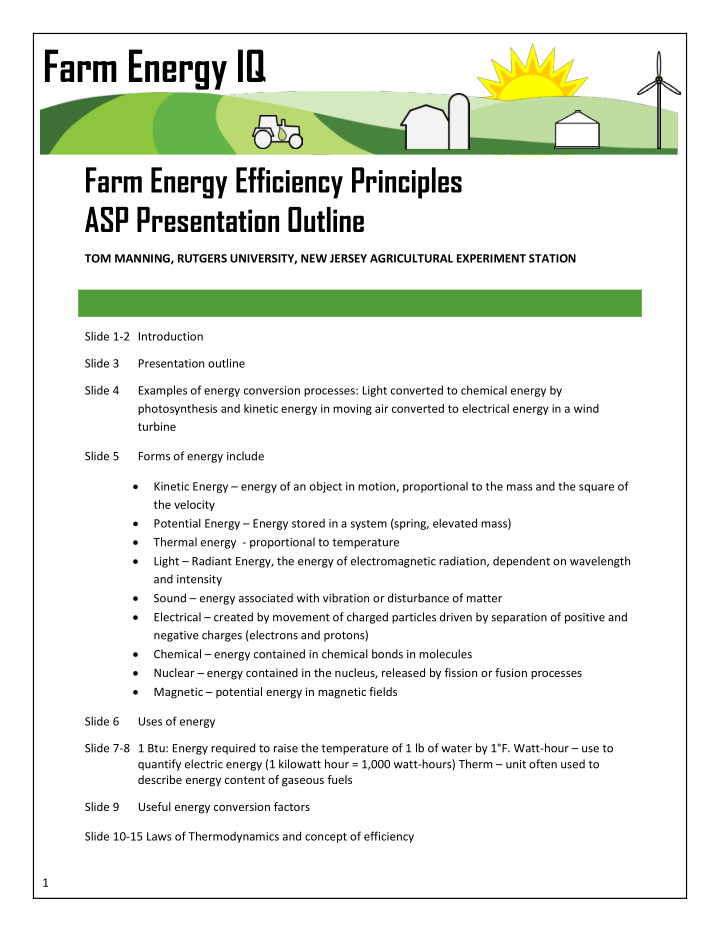



Farm Energy IQ Farm Energy Efficiency Principles ASP Presentation Outline TOM MANNING, RUTGERS UNIVERSITY, NEW JERSEY AGRICULTURAL EXPERIMENT STATION Slide 1-2 Introduction Slide 3 Presentation outline Slide 4 Examples of energy conversion processes: Light converted to chemical energy by photosynthesis and kinetic energy in moving air converted to electrical energy in a wind turbine Slide 5 Forms of energy include • Kinetic Energy – energy of an object in motion, proportional to the mass and the square of the velocity • Potential Energy – Energy stored in a system (spring, elevated mass) • Thermal energy - proportional to temperature • Light – Radiant Energy, the energy of electromagnetic radiation, dependent on wavelength and intensity • Sound – energy associated with vibration or disturbance of matter • Electrical – created by movement of charged particles driven by separation of positive and negative charges (electrons and protons) • Chemical – energy contained in chemical bonds in molecules • Nuclear – energy contained in the nucleus, released by fission or fusion processes • Magnetic – potential energy in magnetic fields Slide 6 Uses of energy Slide 7-8 1 Btu: Energy required to raise the temperature of 1 lb of water by 1°F. Watt-hour – use to quantify electric energy (1 kilowatt hour = 1,000 watt-hours) Therm – unit often used to describe energy content of gaseous fuels Slide 9 Useful energy conversion factors Slide 10-15 Laws of Thermodynamics and concept of efficiency 1
Slide 16 In most cases, heating efficiency depends a lot on the combustion equipment that is used. Natural gas and propane heaters are typically more efficient than oil. Wood burning in inefficient stoves and fireplaces can be less than 0% efficient, attributable to combustion air requirements supplied by infiltration. Slide 17 AFUE, HSPF and SEER are standards developed to help compare expected seasonal performance of equipment. They are not always appropriate when comparing equipment that will not operate according to more common commercial, residential and industrial schedules. A more accurate comparison in some agricultural operations may require evaluating the equipment performance over the expected range of operating conditions. Slide 18 Energy efficiency depends on matching the solution to the problem, so a comprehensive understanding of the energy needs is essential. Slide 19-22 Energy issues and concepts Slide 23 Greenhouse thermal screens add insulation and a radiative barrier and reduce heat losses, as shown in the infrared photograph. Covers for exhaust fans reduce infiltration losses and heat transfer. Slide 24 This is a very common problem. Engineers are often trained to oversize equipment to provide a margin of safety. Where this results in redundancy of equipment it has potential benefits. Generally, oversize equipment costs more to install and operates less efficiently. Short cycling frequently reduces the life of the equipment. Oversize equipment is often more difficult to control, leading to problems like undesirable temperature oscillations. Slide 25 Stand-alone greenhouses (upper left) have a higher surface area to growing area ratio, making for a less energy efficient structure. Double polyethylene greenhouses (upper right) use about 2/3s of the energy of single glass greenhouses (lower left). Very large greenhouse ranges (lower right) have a very low wall area to roof area ratio. Slide 26 Condensing boilers use large heat exchange areas (using stainless steel) to remove more heat from combustion gases. Water will condense in the heater, requiring the use of corrosion resistant materials. Energy recovery systems include heat exchangers to transfer heat from exhaust air to fresh inlet air. On demand water heaters don’t have storage capacity, reducing standby losses. Controls modulate combustion and water flow to maintain the desired water temperature. Slide 27 Variable Frequency Drive allows motor power to match the instantaneous load. Slide 28 Combined heat and power systems have the potential for overall efficiencies above 70%, in contrast to typical efficiencies less than 40% for electrical generation alone. The process of generating electricity using a turbine produces high temperature exhaust gases. Heat extracted from the exhaust gases can be used for space heating or other purposes. Slide 29 Picture shows a greenhouse that makes use of almost all available space. 2
Slide 30 Evaporative cooling uses the latent heat (heat required to change from liquid to vapor) or water to provide cooling by extracting the heat from air. Economizer cycles increases the use of outside makeup air in air condition systems when the outdoor temperature is low enough to provide cooling of the space. Burning waste oil, pelletized biomass or other available alternative fuels is not strictly speaking an energy efficiency measure, but fuel switching. These fuel replacements may cut costs but may increase or decrease actual energy use. Slide 31 Other opportunities Slide 32 Renewable and alternative energies are often first on the list of solutions that people wish to implement. They are rarely the most economical approach to a specific energy problem, and should be evaluated in light of these recommendations. Slide 33 Summary This project supported by the Northeast Sustainable Agriculture Research and Education (SARE) program. SARE is a program of the National Institute of Food and Agriculture, U.S. Department of Agriculture. Significant efforts have been made to ensure the accuracy of the material in this report, but errors do occasionally occur, and variations in system performance are to be expected from location to location and from year to year. Any mention of brand names or models in this report is intended to be of an educational nature only, and does not imply any endorsement for or against the product. The organizations participating in this project are committed to equal access to programs, facilities, admission and employment for all persons. 3
Recommend
More recommend